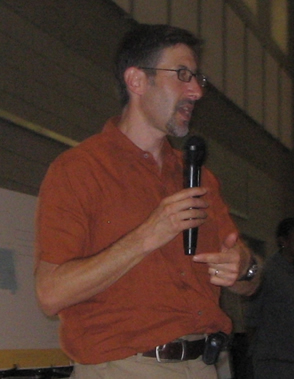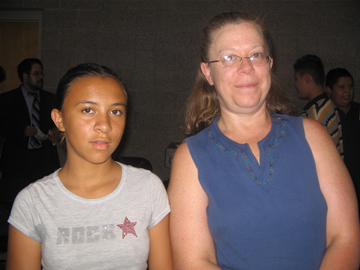By Linda Y. Brown
It’s been more than a year since Manual High School in northeast Denver said goodbye to over 500 students, who scattered across the city to other high schools. Since then, controversy, community councils, district staff visits to well-performing schools in other cities, a nationwide search for a principal, and almost $1 million in renovations have resulted.
As another school year approaches, Manual is making last-minute preparations to open its doors at 2759 Williams St. to 141 students, who have registered and signed commitment forms, along with their parents. An additional 35 students are expected to register by the first day of school on August 20.
 Dr. Rob Stein, who was hired as principal in March, is a 1978 graduate of Manual High School and went on to receive his doctorate from Harvard. He first came to Manual through court-ordered busing in 1975, and has no intention of allowing the new Manual to resemble anything like his experience. Dr. Rob Stein, who was hired as principal in March, is a 1978 graduate of Manual High School and went on to receive his doctorate from Harvard. He first came to Manual through court-ordered busing in 1975, and has no intention of allowing the new Manual to resemble anything like his experience.
He says Manual back then was “segregated under one roof,” and the new Manual will not only be different from his old Manual, but different from any other high school in Denver.
“It’s going to be a lot more intensive in its level of support for students and in the degree to which we know each student well, and address and attend to their individual needs. We call that personalization,” Stein says.
At a community gathering in July, the new principal told students, “When you come in the school three days a week you’ll be meeting with an advisor, who has 15 students like you, whose job it is to make sure that you come to school, you get your work done, if you have problems at home or problems at school, that they get addressed immediately.”
“I think what you’re going to find is a much more intentional community of learners in this school of students, who get to know each other better and develop a higher level of respect as they get to know each other,” assured Stein.
The new Manual will be a technology-rich environment with one computer for every two students to enhance the learning experience, promises Stein.
The school will have 90-minute classes, with 25 to 27 students to a teacher. Stein says he’s never worked with a more energetic and enthusiastic group of professionals than the new teaching staff. All but one are seasoned teachers, and one-third are teachers of color with an almost 50-50 split between male and female teachers.
Students will be required to wear what he terms as business attire, which includes a collared shirt and slacks – no jeans or logo wear, and it will be a closed campus.
Many Optimistic About School Plans, Staff
Newly elected Denver District 8 Councilwoman Carla Madison says she’s glad to see Manual reopening.
“I’ve always been an advocate of neighborhood schools,” Madison explains, adding that a neighborhood school is good for afterschool programs and makes it easier for kids to walk to school.
In this era of global warming, walking to school saves the environment and is less harsh on the communities than driving or taking public transportation, she adds.
Kevin Patterson, Denver Public Schools board representative for northeast Denver, is proud to be able to show the community the board was serious about reopening Manual. Patterson believes starting with the freshman class is the right thing to do, because studies show when new high schools open gradually students perform more successfully.
 Carolynn Dean, left, and Cedric Williams are incoming Manual freshmen, who attended a community meeting with their mothers last month. Carolyn says she’s excited about attending Manual. Her mother, Heidi Huseman-Dean, right, says she has done her research on Stein and feels comfortable with sending her daughter to his school. Carolynn Dean, left, and Cedric Williams are incoming Manual freshmen, who attended a community meeting with their mothers last month. Carolyn says she’s excited about attending Manual. Her mother, Heidi Huseman-Dean, right, says she has done her research on Stein and feels comfortable with sending her daughter to his school.
Cedric’s mother, Yolanda Williams, is also excited about sending her son to Manual. She says he’s nervous, but it has more to do with going to high school rather than attending Manual.
As Cedric toured the building, Yolanda explained that she, along with Metro-State ACTS (Asking Communities to Stand) where she sits on the board, have done their homework on Stein. The organization is concerned with preparing more minority kids for college, equipping them, and making available resources to help them accomplish this goal. She hopes that DPS will take advantage of this opportunity to prepare the first group of Manual students, and get them pumped up about college. Knowing that her son will be starting school with other freshmen, without the pressures of having upper-classmen around, is reassuring, she says.
District Offices May Share Manual
Although officials say it’s not a done deal, they are looking at moving 300 personnel and the DPS administrative offices, currently located at 900 Grant St., into the unused portion of Manual High School. Plans have already been drawn up to show what that scenario would look like, but the school board has not voted on its final decision, nor has the district received all community input on the matter.
Happy Haynes, assistant to the superintendent for community partnerships, believes the move would be good for the community as well as for administrators.
“Our belief is that a move like this brings the administrators right into the middle of a working school and helps to remind us every day about what we’re here for. We’re here for students, and we all do different jobs to support our schools and our students. But, when we’re sitting across town in another building, it’s a little further from your mind. Being here in a working school really brings it close to home. For every person in the administration, this is what we’re about every day when we come to work – we’re here to support the learning of students and it’s a daily reminder,” Haynes explains.
Haynes believes the move will benefit the community by bringing in more jobs and supporting local businesses. She also states that the administration will not be imposing itself on Manual or its students. The amount of interaction between the two will be at the discretion of Manual.
Stein adds, “I think we do a mistake in our society by isolating young people from adults. I think this will benefit us greatly by having adults have regular contact with students. We’re always saying we need more adults as mentors and role models, and we’ll have a supply of 300 people from which to draw right here on the campus. Now, I know from a 14 year old’s perspective it doesn’t always sound so inviting to be surrounded by adults, but as a parent myself, and an educator myself, I do like that kids come in regular contact with older people.”
Parent Communication, Representation Sought
Cautiously optimistic is what you might want to call northeast Denver community activist Jorge Merida about the new Manual. He fought hard to never see it close in the first place. He was a member of the Community Council that looked at best practices in urban education, and met with potential candidates for the principal position. Although he fully supports the parents and their students, he is keeping an eye on the district to make sure they do the right thing in all areas concerning Manual.
“I don’t necessarily think that everything that we wanted is being done," he said. "Even though the school probably will be at least 50 percent Hispanic, I think Hispanics are being an object of second thought. Many of the significant communications, like letters to the parents, have been sent out only in English. Even though all of the Hispanic students are completely bilingual –that is not the case with the parents – most of the parents are monolingual. I’ve seen many instances already where I’ve had to, and I’m not getting paid, but I’m the one who has to say ‘excuse me but this paper was not translated in Spanish to the parents. It’s like ‘Oh yea, we’ve got Spanish parents,’ and that kind of bothers me because it’s almost the same as to what was going on before. I don’t blame anybody. I just think it’s a lack of consciousness. I think Black parents can relate to it because they have had their needs and voices not heard and have often been treated as an afterthought. I guess that’s not fashionable in this country anymore – to be sensitive to minorities."
Merida is in the process of identifying and organizing at least 40 to 50 parents of Manual students to come out in full force and participate in a day of cleaning up, painting, and revitalization on August 9. The nationally-airing Good Morning America on ABC will be at Manual to spotlight the event, sponsored by Hands On.
“All of (the parents) should be there, in order to balance out the fact that there are going to be 600 other people, which I can assure you are going to be mostly Anglo, that are coming in from a different part of the town to clean up our school. Well that’s nice – we appreciate that, but we should be there to clean up our school – the parents who’ve already volunteered what I call six pints of blood. What do I mean by that? When you send your kid to that school, to any school, you are sending …six pints of blood somewhere else. These parents, 141 who have signed and made a commitment to send their kids to the new Manual, well, 141 have sent six pints of blood to a school that has not proven itself yet – all on faith. Well, I have faith in Jesus! And these parents should be overseeing what’s going to happen with their six pints of blood,” said Merida, who plans to have T-shirts made up to identify the parents of the new Manual students on August 9.
“I don’t want the mayor, I don’t want the governor, I don’t want the superintendent, or the council to be there. I want the parents – they’re the ones who deserve the spotlight,” he said.
Return To Top |
